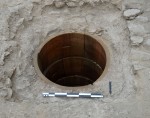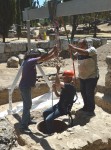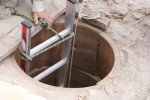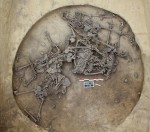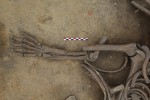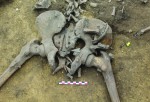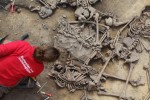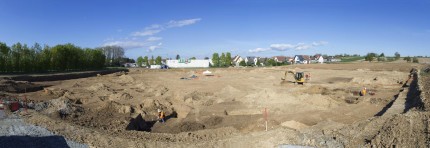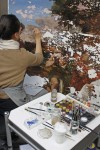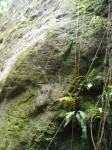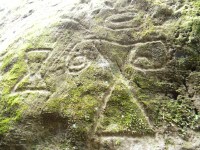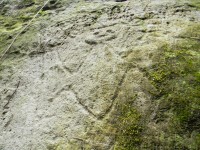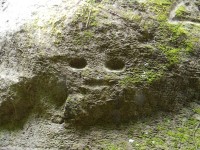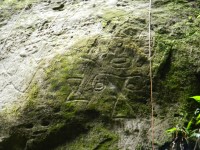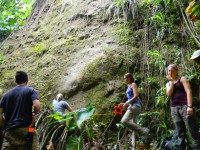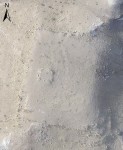 Archaeologists using high-resolution satellite imagery and drone photography have discovered a massive structure in the ancient city of Petra in Jordan. The UNESCO World Heritage Site, known as the Rose City after the red sandstone of the rock cliffs its most famous buildings were cut into, was built by the Nabateans beginning in the 2nd century BC and prospered as a trade hub linking East and West. It was abandoned in the 7th century and rediscovered by Swiss explorer Johann Burckhardt in 1812. Since then, it has been extensively explored. Finding a previously unknown structure of monumental dimensions is therefore unexpected, to say the least, especially half a mile south of the main city center.
Archaeologists using high-resolution satellite imagery and drone photography have discovered a massive structure in the ancient city of Petra in Jordan. The UNESCO World Heritage Site, known as the Rose City after the red sandstone of the rock cliffs its most famous buildings were cut into, was built by the Nabateans beginning in the 2nd century BC and prospered as a trade hub linking East and West. It was abandoned in the 7th century and rediscovered by Swiss explorer Johann Burckhardt in 1812. Since then, it has been extensively explored. Finding a previously unknown structure of monumental dimensions is therefore unexpected, to say the least, especially half a mile south of the main city center.
Archaeologist Christopher Tuttle, who has worked at Petra for nigh on 20 years, collaborated with everyone’s favorite (only?) space archaeologist Sarah Parcak, who scanned the satellite imagery for spots of interest. She saw a large rectangular shape with a smaller rectangle inside it at a site that Tuttle was somewhat familiar with, but the glimpse he’d seen of it looked like there were just a few crumbling terrace walls of a type widely seen all over the city. Tuttle then took to the field to discover if there was anything of note at the site. Aerial drone photography confirmed the outlines of an ancient structure worth exploring further, and then Tuttle took to the field to examine the site with his own eyes.
He realized that it wasn’t busted old terrace walls but rather the remains of a massive previously unknown building. Some pottery found there dates back to 150 BC, which may indicate the platform was built in the early days of Petra’s founding.
The newly revealed structure consists of a 184-by-161-foot (about 56-by-49-meter) platform that encloses a slightly smaller platform originally paved with flagstones. The east side of the interior platform had been lined with a row of columns that once crowned a monumental staircase.
A small 28-by-28-foot (8.5-by-8.5-meter) building was centered north-south atop the interior platform and opened to the east, facing the staircase.
This enormous open platform, topped with a relatively small building and approached by a monumental facade, has no known parallels to any other structure in Petra. It most likely had a public, ceremonial function, which may make it the second largest elevated, dedicated display area yet known in Petra after the Monastery.
 Most of the large public monuments, including the Monastery (which is actually a temple), were built between the late 1st century B.C. and the 2nd century A.D., so if the pottery dates pan out, the platform could be the oldest structure in Petra of monumental scale. It’s not clear how the Nabateans used these shrines as they left no written records and few hints carved in the stone since their religious monuments eschewed icons for the most part, or used portable figures that are long gone.
Most of the large public monuments, including the Monastery (which is actually a temple), were built between the late 1st century B.C. and the 2nd century A.D., so if the pottery dates pan out, the platform could be the oldest structure in Petra of monumental scale. It’s not clear how the Nabateans used these shrines as they left no written records and few hints carved in the stone since their religious monuments eschewed icons for the most part, or used portable figures that are long gone.
There are no current plans to excavate the site. Tuttle and Parcak have co-authored a study on the find published in the Bulletin of the American Schools of Oriental Research. It can be read here if you have a JSTOR login or nine bucks to spare.
You can take a virtual walk through the glories of Petra with Google Street View. Also, PBS’ always excellent NOVA had a fascinating episode last year on how the great buildings and elaborate water systems of Petra were constructed. It’s jaw-dropping at times. The Nabateans were genius engineers, truly.

